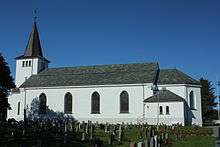Herdla Church
| Herdla Church | |
|---|---|
| Herdla kirke | |
 View of the church | |
 Herdla Church Location in Hordaland county  Herdla Church Location in Hordaland county | |
| 60°34′06″N 4°57′02″E / 60.5682°N 4.9505°ECoordinates: 60°34′06″N 4°57′02″E / 60.5682°N 4.9505°E | |
| Location | Askøy, Hordaland |
| Country | Norway |
| Denomination | Church of Norway |
| Churchmanship | Evangelical Lutheran |
| History | |
| Founded | 12th century |
| Architecture | |
| Status | Parish church |
| Functional status | Active |
| Completed | 1950 |
| Specifications | |
| Capacity | 600 |
| Materials | Stone |
| Administration | |
| Parish | Herdla |
| Deanery | Vesthordland prosti |
| Diocese | Diocese of Bjørgvin |
Herdla Church (Norwegian: Herdla kirke) is a parish church in Askøy municipality in Hordaland county, Norway. It is located the small island of Herdla. The church is part of the Herdla parish in the Vesthordland deanery in the Diocese of Bjørgvin.[1][2]
History
First church
The oldest written accounts of this church on Herdla is a letter from Pope Eugenius III in 1146 that mentions "St. Nicholas's Church on Herdla" Latin: Ecclesiam sancti Nicholai de hardle. The church was consecrated Saint Nicholas of Myra, the patron saint of sailors. The church had similarities with Moster Church and Kinn Church, both stone churches without towers. The church belonged under Munkeliv monastery in the nearby city of Bergen. The monastery was founded by King Øystein I Magnusson around 1110. Herdla Church began as a stone church in simple Romanesque style, but was later rebuilt in Gothic style with pointed arches.[3][4]
Second church
Following storm damage, the church was demolished in 1861 and a larger church was built in 1863. This church burned down in 1934.[3][4]
Third church
After rebuilding, the church was nicknamed the "Øygard Cathedral". The church served most of the old municipality of Herdla which included parts of the present-day municipalities of Øygarden, Askøy, and Meland. During World War II, the church was seriously damaged. The Germans blew up the tower and the church was used to store ammunition and it was also used as horse stalls. Under the floor, a large tunnel system was built that went across the island, including underneath much of the cemetery. During the war years, the island of Herdla was used as a large airfield and the Germans blew off the tower because they were afraid that the church tower could serve as landmark for bombers who came from Britain.[3][4]
Fourth church
A new church was completed on Herdla in 1951. This new, white, stone church was built by the architect Ole Halvorsen. This large church can seat up to 600 people. It was consecrated on 1 April 1951 by the Bishop Ragnvald Indrebø. The church has a lower tower than before, because at that time there were plans to make Herdla the main airport for the city of Bergen. However, Herdla was ultimately not chosen and they airport was built in Flesland in 1955. In May 2008, the low church tower was removed and a larger tower was built, similar to the tower that the German's blew up during World War II.[3][4]
See also
References
- ↑ "Herdla kirke". Kirkesøk: Kirkebyggdatabasen.
- ↑ "Oversikt over Nåværende Kirker" (in Norwegian). KirkeKonsulenten.no. Retrieved 2014-11-18.
- 1 2 3 4 "Herdla kirke" (in Norwegian). Norges Kirker. Retrieved 2014-11-18.
- 1 2 3 4 "Kirker i Hordaland fylke" (in Norwegian). DIS-Hordaland. Retrieved 2014-11-18.